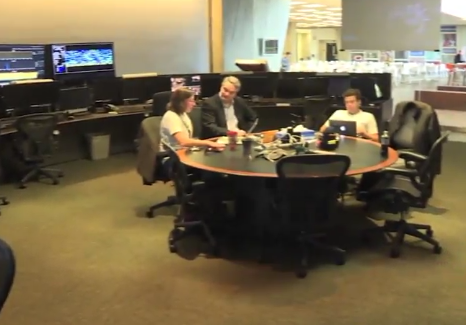For decades, the so-called standard model in physics has been the gold standard outlining what scientists know about the basic subatomic building blocks of everything known to man.
几十年来,物理学中所谓的标准模型一直是黄金标准,概述了科学家对人类所知的一切基本亚原子组成部分的认知。
Over the years, they have identified 17 fundamental particles and three forces.
多年来,他们已经确定了17种基本粒子和三种力。
It's the electromagnetic force, the weak force which is connected to nuclear decay and then also the strong force which is what basically holds you know your protons and your neutrons inside of the nucleus and basically makes everything that we are, the structure that we are.
包括电磁力,与核衰变有关的弱力,还有强力,强力基本就是把人体中质子和中子留在原子核里的力,它造就了人类的一切。
Renee Fatemi is a professor of physics at the University of Kentucky and is part of an international team at Fermilab outside Chicago.
蕾妮·法特米是肯塔基大学的物理学教授,也是芝加哥城外费米实验室(Fermilab)国际团队的一员。
Partnering with the European organization for nuclear research or CERN in Switzerland, the team is trying to unlock the subatomic secrets of the universe.
该团队与位于瑞士的欧洲核子研究中心合作,试图解开宇宙亚原子的秘密。
There's always this force and it's a question of tapping into it.
这种力量一直都存在,问题是如何接近它。
We're trying to figure out the new forces and particles.
我们想弄明白这种新的力和粒子。
An experiment at Fermilab aims to tap into the unknown.
费米实验室的一项实验旨在探索未知。

Of particular interest is the muon, one of 17 particles similar to an electron.
特别有趣的是介子,它是17种类似于电子的粒子之一。
A byproduct of cosmic rays, muons constantly blanket earth's surface.
作为宇宙射线的副产品,介子一直覆盖在地球表面。
Fermilab used a specially designed 14-meter circular magnetic track to study how muons move through space.
费米实验室使用了一个特殊设计的14米长的圆形磁轨道来研究介子在空间中的运动。
Data from billions of tests are challenging fundamental principles of the standard model known to generations of physicists.
数十亿次测试的数据结果正在挑战一代又一代物理学家所熟知的标准模型的基本原理。
We got a real hint, a real possibility that there could be a breakdown of all the fundamental things that we thought we knew.
我们真的得到了一个线索,它可能会让我们所熟知的所有基本的知识瞬间崩塌。
Marcela Carena, head of theoretical physics at Fermilab says the experiment is detecting phenomena that cannot be explained by the model that physicists constructed in the 1970s and updated as recently as 2012.
费米实验室的理论物理学主任Marcela Carena说,这个实验探测到了一些现象,这些现象无法用物理学家在20世纪70年代建立的模型来解释,而这个模型最近是在2012年有所更新。
Specifically, some unknown force or particle is interacting with muons in ways not predicted by the standard model.
具体来说,一些未知的力或粒子会以标准模型无法预测的方式与介子相互作用。
So what exactly is it? Carena says data collected at Fermilab could hold the answer.
那它到底是什么呢?Carena说,在费米实验室收集的数据或许能告诉我们答案。
Analysis has only just begun but hints at the possibility of a major discovery.
分析才刚刚开始,但暗示了重大发现的可能性。
There could be one or more particles that are starting to talk with the new one.
可能有一种或多种粒子开始与新粒子相互作用。
I knew that this result would be could be possibly a watershed moment for physicists.
我知道这个结果可能会成为物理学家的分水岭。
I mean, it's like finally finally now we have a hint of where to go next.
我的意思是,我们终于发现了下一个探索的方向。
The particle breakthrough has led to a surge of interest in Fatimi's work.
粒子的突破使人们对法蒂米的工作兴趣大增。
Talking about muons and standard models I mean nobody says talks about that over dinner right.
说到介子和标准模型,以前没有人会在吃晚饭的时候谈论这些。
I mean so but hey now they do and that's super cool.
但现在,他们会在晚饭期间讨论这些东西,太酷了。
Well Fermilab’s muon experiment continues.
费米实验室的介子实验还在继续。
Marcella Carrena says the next phase of research could yield more clues by smashing or colliding the particles together.
Marcella Carrena表示,下一阶段的研究可以通过粉碎或碰撞粒子获取更多线索。
Doing that might require more advanced technology than Fermilab’s accelerator or even the large hadron collider at CERN's facility in Europe.
要做到这一点,可能需要比费米实验室的加速器甚至欧洲核子研究中心的大型强子对撞机更先进的技术。











